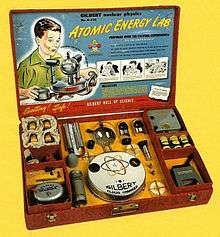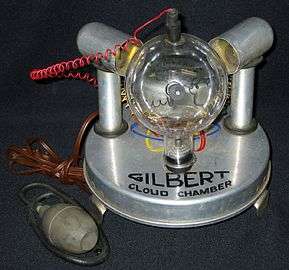Gilbert U-238 Atomic Energy Laboratory

The Gilbert U-238 Atomic Energy Lab is a toy lab set that was produced by Alfred Carlton Gilbert, who was an American athlete, magician, toy-maker, business man, and inventor of the well-known Erector Set. The Atomic Energy Lab was released by the A. C. Gilbert Company in 1950. The kit's intention was to allow children to create and watch nuclear and chemical reactions using radioactive material.
Background and development
Gilbert believed that toys were the foundation in building a "solid American character", and many of his toys had some type of educational significance to them. Gilbert was even dubbed "the man who saved Christmas" during World War I when he convinced the US Council of National Defense not to ban toy purchases during Christmas time.[1]
The Atomic Energy Lab was just one of a dozen chemical reactions lab kits on the market at the time. Gilbert’s toys often included instructions on how the child could use the set to put on his own "magic show". For parents, he pushed the idea that the sets' use of chemical reactions directed their children toward a potential career in science and engineering.[2]
In 1954, Gilbert wrote in his autobiography, The Man Who Lives in Paradise, that the Atomic Energy Laboratory was "the most spectacular of [their] new educational toys". Gilbert wrote that the Government encouraged the set's development because it believed the lab would aid public understanding of atomic energy and emphasize its constructive aspects. Gilbert also defended his Atomic Energy Laboratory, stating it was safe, accurate,[3] and that some of the country's best nuclear physicists had worked on the project.[4]:333-334
Description

The lab contained a cloud chamber allowing the viewer to watch alpha particles traveling at 12,000 miles per second (19,000,000 m/s), a spinthariscope showing the results of radioactive disintegration on a fluorescent screen, and an electroscope measuring the radioactivity of different substances in the set.
Decades later, the lab set was criticized as "the world's most dangerous toy" because of the radioactive material it included.[5] Gilbert's original promotions claimed that none of the materials could prove dangerous.[4]:333-334 However, the instructions cautioned, "users should not take ore samples out of their jars, for they tend to flake and crumble and you would run the risk of having radioactive ore spread out in your laboratory. This would raise the level of your background count."[3]
The set originally sold for $49.50[3] ($503 today)[6] and contained the following:[3][7][8]
- Battery-powered Geiger–Müller counter
- Electroscope
- Spinthariscope
- Wilson cloud chamber
- Four glass jars containing uranium-bearing ore samples (autunite, torbernite, uraninite, and carnotite from the "Colorado plateau region"),[3] serving as low-level radiation sources of:
- Alpha particles (Pb-210 and Po-210)[9]
- Beta particles (Ru-106)[9]
- Gamma rays (possibly Zn-65)[9]
- "Nuclear spheres" for making a model of an alpha particle
- Gilbert Atomic Energy Manual — a 60-page instruction book
- Learn How Dagwood Split the Atom — comic book introduction to radioactivity
- Prospecting for Uranium — a book
- Three C batteries
- 1951 Gilbert Toys catalog
A product catalog described the set as follows: "Produces awe-inspiring sights! Enables you to actually SEE the paths of electrons and alpha particles traveling at speeds of more than 10,000 miles per SECOND! Electrons racing at fantastic velocities produce delicate, intricate paths of electrical condensation – beautiful to watch. Viewing Cloud Chamber action is closest man has come to watching the Atom! Assembly kit (Chamber can be put together in a few minutes) includes Dri-Electric Power Pack, Deionizer, Compression Bulb, Glass Viewing Chamber, Tubings, Power Leads, Stand, and Legs."
Among other activities, the kit suggested "playing hide and seek with the gamma ray source", challenging players to use the Geiger counter to locate a radioactive sample hidden in a room.[3]
Legacy
Unlike other A.C. Gilbert Company chemistry sets, the Atomic Energy Lab was never popular and was soon taken off the shelves.[5] Fewer than 5000 kits were sold, and the product was only offered in 1950 and 1951.[3] Gilbert believed the Atomic Energy Lab was commercially unsuccessful because the lab was more appropriate for those who had some educational background rather than the younger crowd that the A.C. Gilbert Company aimed for. Columbia University purchased five of these sets for their physics lab.[3][4]:333-334
References
- ↑ Watson, B (1999) Hello Boys! Become an erector master engineer. Smithsonian, 30(2), 120
- ↑ DiVernieri, R. (2008, September) "Stinks and bangs: The heyday of the chemistry set" Endeavour 32(3) p.107-110
- 1 2 3 4 5 6 7 8 Watson, Bruce (2002). The man who changed how boys and toys were made. New York.: Viking. pp. 179–181. ISBN 0670031348.
- 1 2 3 Gilbert, A. C. (1954) The Man Who Lives in Paradise
- 1 2 Berry Drago, Elisabeth (2016). "Hazardous Fun". Distillations. 2 (2): 8–9. Retrieved 23 March 2018.
- ↑ Inflation.
- ↑ American Memorabilia Archived 2007-09-03 at the Wayback Machine.
- ↑ Google Answers,
- 1 2 3 Oak Ridge Associated Universities, retrieved December 26, 2009